power steering TOYOTA YARIS HATCHBACK 2015 Owners Manual
[x] Cancel search | Manufacturer: TOYOTA, Model Year: 2015, Model line: YARIS HATCHBACK, Model: TOYOTA YARIS HATCHBACK 2015Pages: 540, PDF Size: 34.12 MB
Page 2 of 540
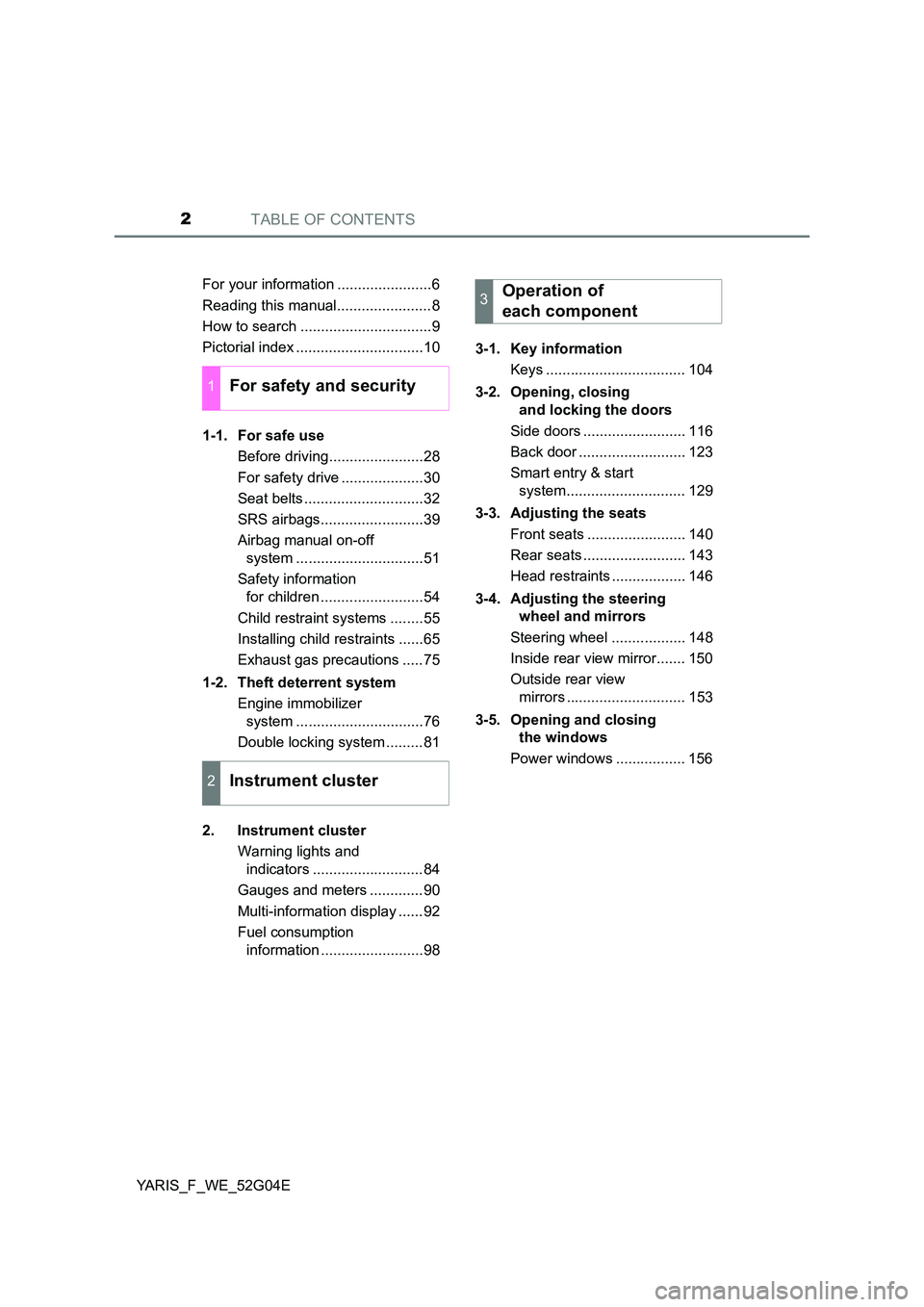
TABLE OF CONTENTS2
YARIS_F_WE_52G04E
For your information .......................6
Reading this manual.......................8
How to search ................................9
Pictorial index ...............................10
1-1. For safe use
Before driving.......................28
For safety drive ....................30
Seat belts .............................32
SRS airbags.........................39
Airbag manual on-off
system ...............................51
Safety information
for children .........................54
Child restraint systems ........55
Installing child restraints ......65
Exhaust gas precautions .....75
1-2. Theft deterrent system
Engine immobilizer
system ...............................76
Double locking system .........81
2. Instrument cluster
Warning lights and
indicators ...........................84
Gauges and meters .............90
Multi-information display ......92
Fuel consumption
information .........................98
3-1. Key information
Keys .................................. 104
3-2. Opening, closing
and locking the doors
Side doors ......................... 116
Back door .......................... 123
Smart entry & start
system............................. 129
3-3. Adjusting the seats
Front seats ........................ 140
Rear seats ......................... 143
Head restraints .................. 146
3-4. Adjusting the steering
wheel and mirrors
Steering wheel .................. 148
Inside rear view mirror....... 150
Outside rear view
mirrors ............................. 153
3-5. Opening and closing
the windows
Power windows ................. 156
1For safety and security
2Instrument cluster
3Operation of
each component
Page 85 of 540
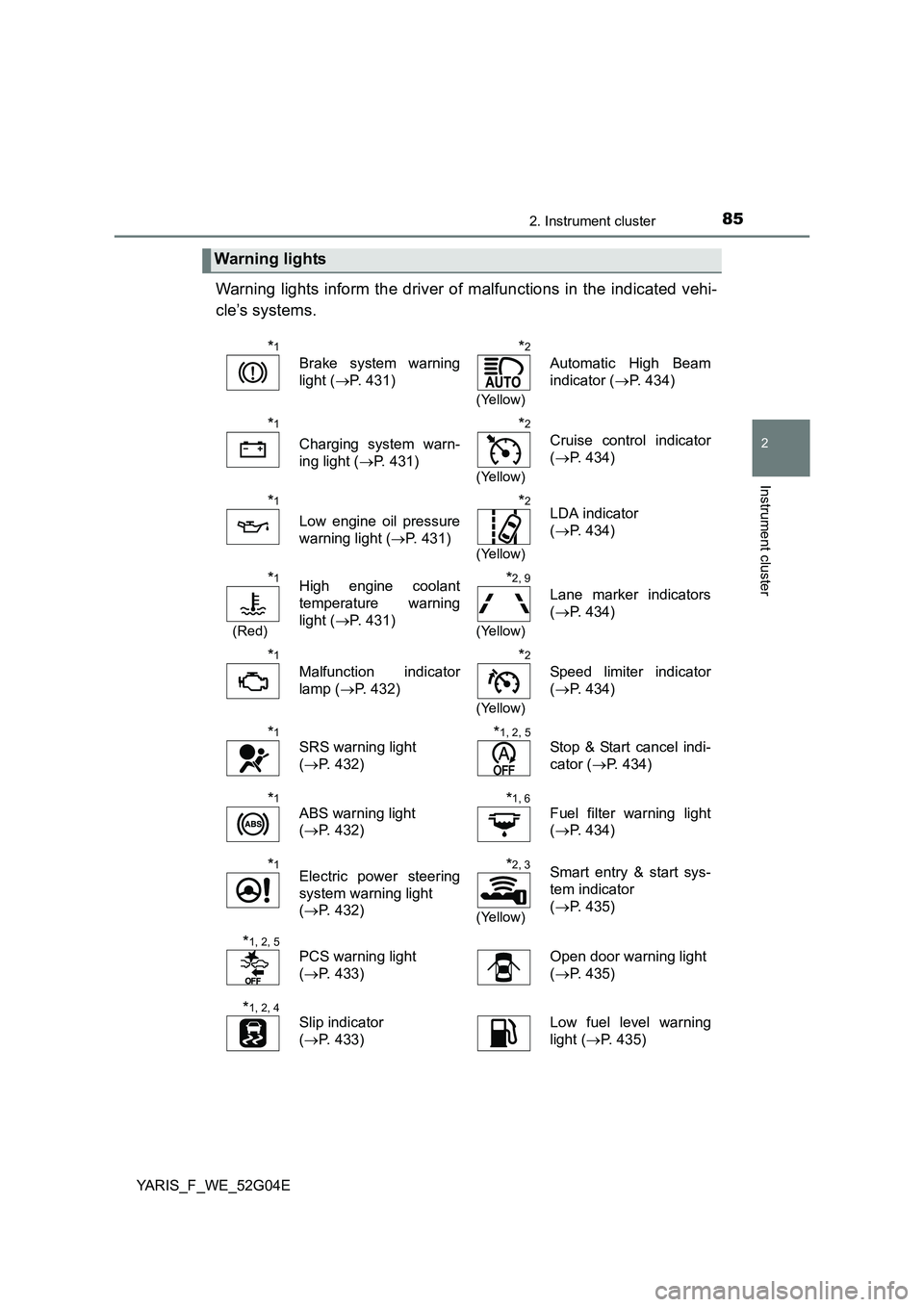
852. Instrument cluster
2
Instrument cluster
YARIS_F_WE_52G04E
Warning lights inform the driver of malfunctions in the indicated vehi-
cle’s systems.
Warning lights
*1
Brake system warning
light ( P. 431)
*2
(Yellow)
Automatic High Beam
indicator ( P. 434)
*1
Charging system warn-
ing light ( P. 431)
*2
(Yellow)
Cruise control indicator
( P. 434)
*1
Low engine oil pressure
warning light ( P. 431)
*2
(Yellow)
LDA indicator
( P. 434)
*1
(Red)
High engine coolant
temperature warning
light ( P. 431)
*2, 9
(Yellow)
Lane marker indicators
( P. 434)
*1
Malfunction indicator
lamp ( P. 432)
*2
(Yellow)
Speed limiter indicator
( P. 434)
*1
SRS warning light
( P. 432)
*1, 2, 5
Stop & Start cancel indi-
cator ( P. 434)
*1
ABS warning light
( P. 432)
*1, 6
Fuel filter warning light
( P. 434)
*1Electric power steering
system warning light
( P. 432)
*2, 3
(Yellow)
Smart entry & start sys-
tem indicator
( P. 435)
*1, 2, 5
PCS warning light
( P. 433)
Open door warning light
( P. 435)
*1, 2, 4
Slip indicator
( P. 433)
Low fuel level warning
light ( P. 435)
Page 103 of 540
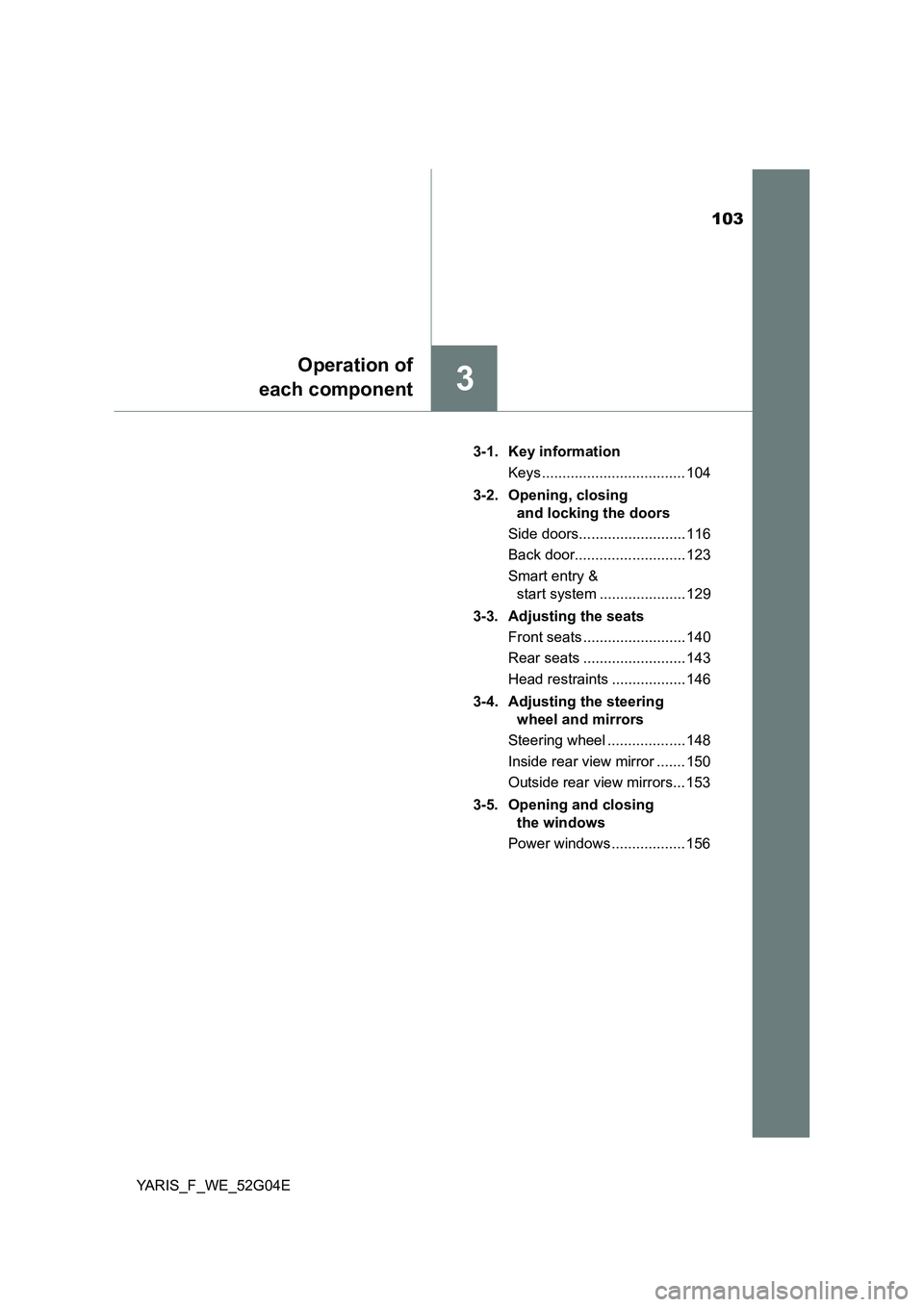
103
3
Operation of
each component
YARIS_F_WE_52G04E
3-1. Key information
Keys ................................... 104
3-2. Opening, closing
and locking the doors
Side doors.......................... 116
Back door........................... 123
Smart entry &
start system ..................... 129
3-3. Adjusting the seats
Front seats ......................... 140
Rear seats ......................... 143
Head restraints .................. 146
3-4. Adjusting the steering
wheel and mirrors
Steering wheel ................... 148
Inside rear view mirror ....... 150
Outside rear view mirrors... 153
3-5. Opening and closing
the windows
Power windows .................. 156
Page 153 of 540
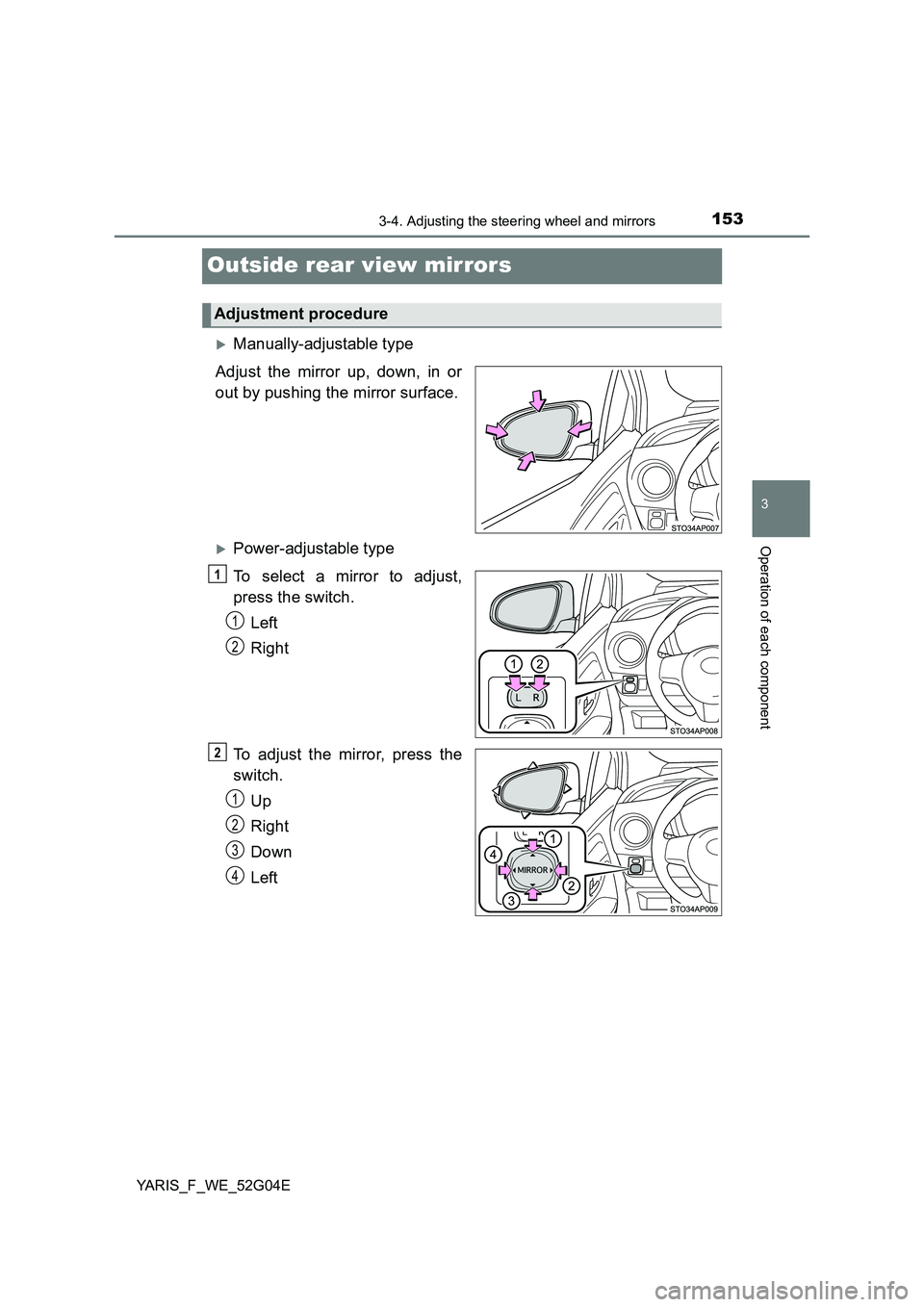
153
3
3-4. Adjusting the steering wheel and mirrors
Operation of each component
YARIS_F_WE_52G04E
Outside rear view mirrors
Manually-adjustable type
Adjust the mirror up, down, in or
out by pushing the mirror surface.
Power-adjustable type
To select a mirror to adjust,
press the switch.
Left
Right
To adjust the mirror, press the
switch.
Up
Right
Down
Left
Adjustment procedure
1
1
2
2
1
2
3
4
Page 154 of 540
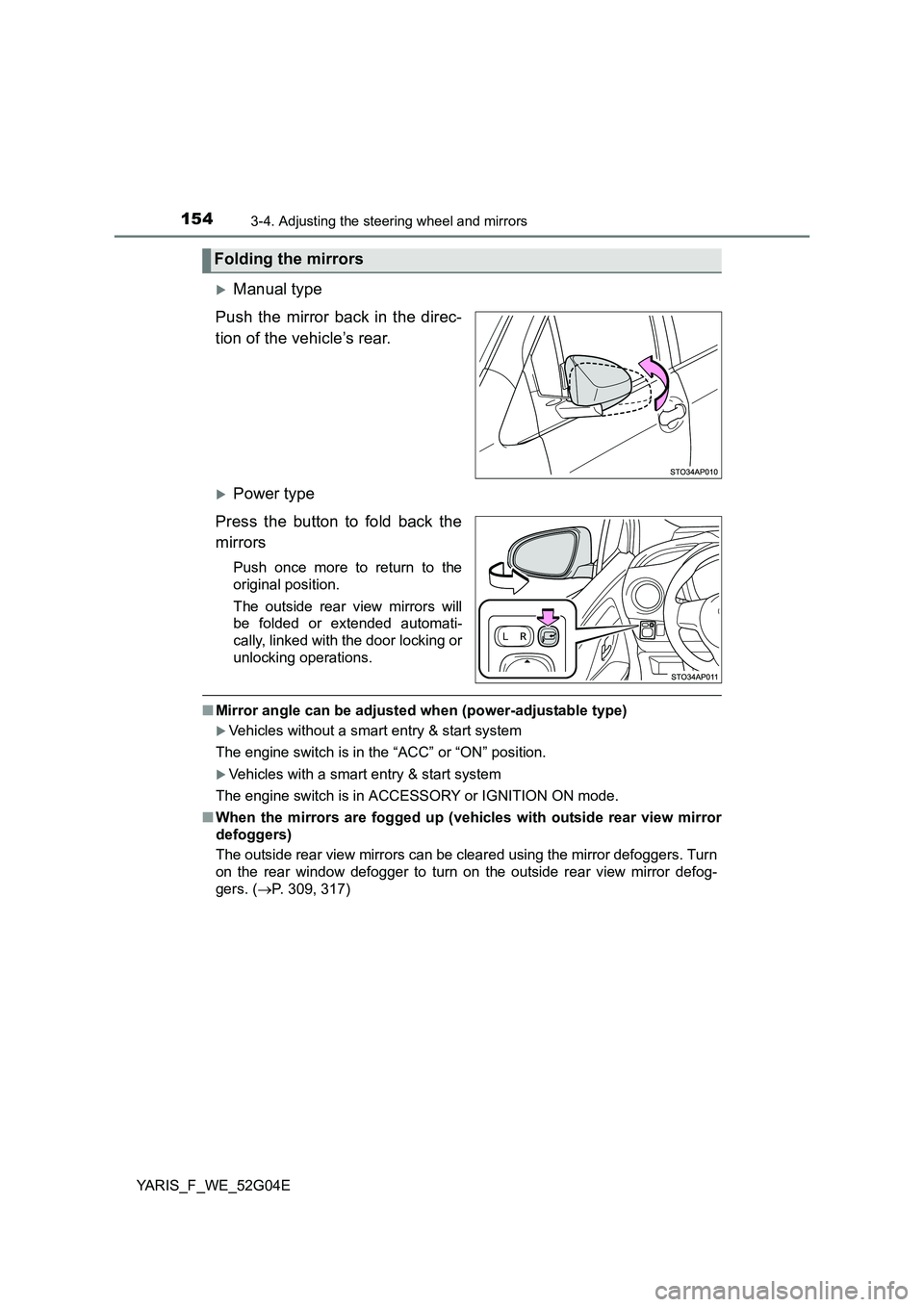
1543-4. Adjusting the steering wheel and mirrors
YARIS_F_WE_52G04E
Manual type
Push the mirror back in the direc-
tion of the vehicle’s rear.
Power type
Press the button to fold back the
mirrors
Push once more to return to the
original position.
The outside rear view mirrors will
be folded or extended automati-
cally, linked with the door locking or
unlocking operations.
■ Mirror angle can be adjusted when (power-adjustable type)
Vehicles without a smart entry & start system
The engine switch is in the “ACC” or “ON” position.
Vehicles with a smart entry & start system
The engine switch is in ACCESSORY or IGNITION ON mode.
■ When the mirrors are fogged up (vehicles with outside rear view mirror
defoggers)
The outside rear view mirrors can be cleared using the mirror defoggers. Turn
on the rear window defogger to turn on the outside rear view mirror defog-
gers. ( P. 309, 317)
Folding the mirrors
Page 155 of 540
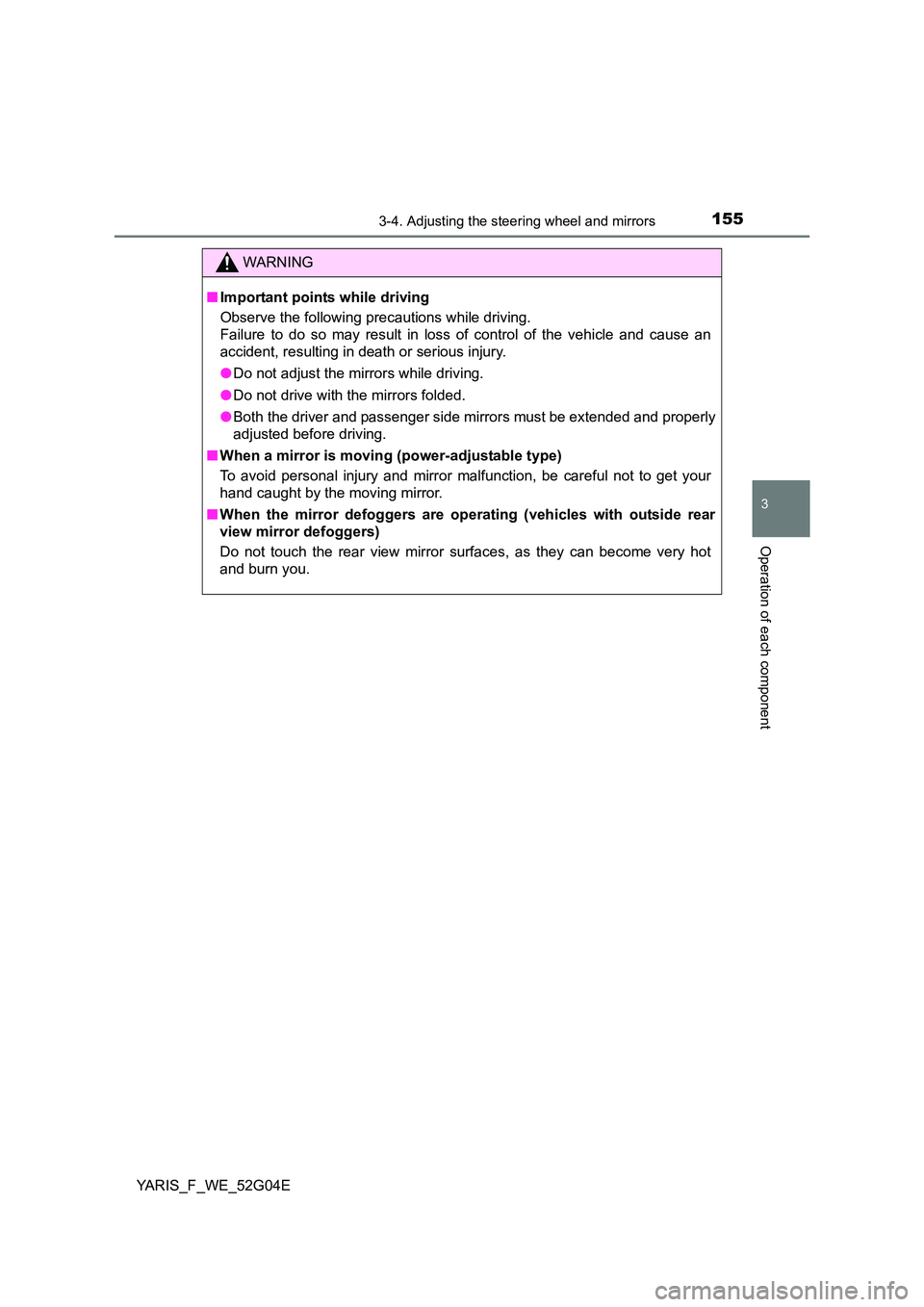
1553-4. Adjusting the steering wheel and mirrors
3
Operation of each component
YARIS_F_WE_52G04E
WARNING
■Important points while driving
Observe the following precautions while driving.
Failure to do so may result in loss of control of the vehicle and cause an
accident, resulting in death or serious injury.
● Do not adjust the mirrors while driving.
● Do not drive with the mirrors folded.
● Both the driver and passenger side mirrors must be extended and properly
adjusted before driving.
■ When a mirror is moving (power-adjustable type)
To avoid personal injury and mirror malfunction, be careful not to get your
hand caught by the moving mirror.
■ When the mirror defoggers are operating (vehicles with outside rear
view mirror defoggers)
Do not touch the rear view mirror surfaces, as they can become very hot
and burn you.
Page 167 of 540
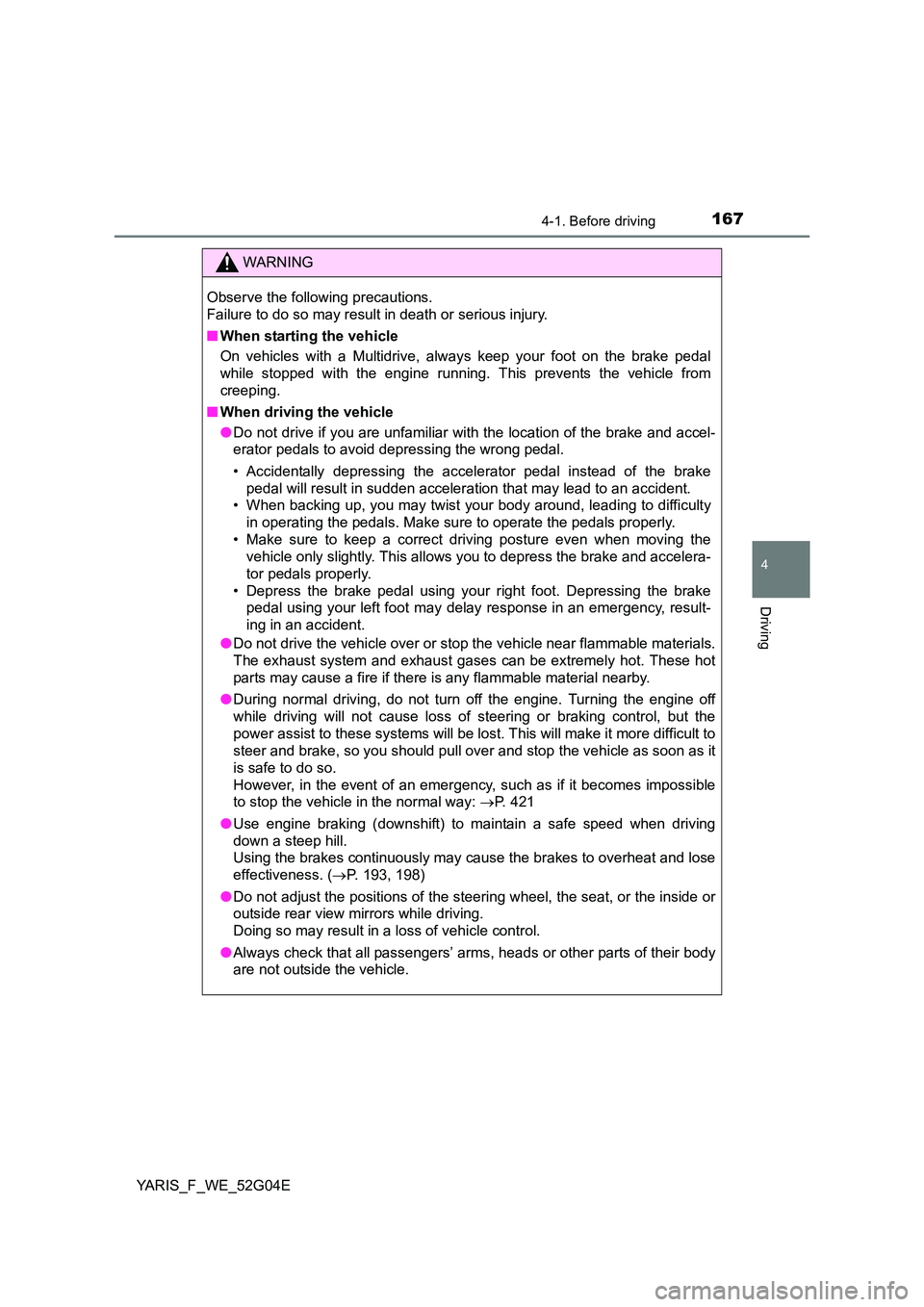
1674-1. Before driving
4
Driving
YARIS_F_WE_52G04E
WARNING
Observe the following precautions.
Failure to do so may result in death or serious injury.
■ When starting the vehicle
On vehicles with a Multidrive, always keep your foot on the brake pedal
while stopped with the engine running. This prevents the vehicle from
creeping.
■ When driving the vehicle
● Do not drive if you are unfamiliar with the location of the brake and accel-
erator pedals to avoid depressing the wrong pedal.
• Accidentally depressing the accelerator pedal instead of the brake
pedal will result in sudden acceleration that may lead to an accident.
• When backing up, you may twist your body around, leading to difficulty
in operating the pedals. Make su re to operate the pedals properly.
• Make sure to keep a correct driving posture even when moving the
vehicle only slightly. This allows you to depress the brake and accelera-
tor pedals properly.
• Depress the brake pedal using your right foot. Depressing the brake
pedal using your left foot may delay response in an emergency, result-
ing in an accident.
● Do not drive the vehicle over or stop the vehicle near flammable materials.
The exhaust system and exhaust gases can be extremely hot. These hot
parts may cause a fire if there is any flammable material nearby.
● During normal driving, do not turn off the engine. Turning the engine off
while driving will not cause loss of steering or braking control, but the
power assist to these systems will be lost. This will make it more difficult to
steer and brake, so you should pull over and stop the vehicle as soon as it
is safe to do so.
However, in the event of an emergency, such as if it becomes impossible
to stop the vehicle in the normal way: P. 421
● Use engine braking (downshift) to maintain a safe speed when driving
down a steep hill.
Using the brakes continuously may cause the brakes to overheat and lose
effectiveness. ( P. 193, 198)
● Do not adjust the positions of the steering wheel, the seat, or the inside or
outside rear view mirrors while driving.
Doing so may result in a loss of vehicle control.
● Always check that all passengers’ arms, heads or other parts of their body
are not outside the vehicle.
Page 172 of 540

1724-1. Before driving
YARIS_F_WE_52G04E
NOTICE
■Avoiding damage to vehicle parts
● Do not turn the steering wheel fully in either direction and hold it there for
an extended period of time.
Doing so may damage the power steering motor.
● When driving over bumps in the road, drive as slowly as possible to avoid
damaging the wheels, underside of the vehicle, etc.
● Diesel engine only: Make sure to idle the engine immediately after high-
speed driving or hill climbing. Stop the engine only after the turbocharger
has cooled down.
Failure to do so may cause damage to the turbocharger.
■ If you get a flat tire while driving
A flat or damaged tire may cause the following situations. Hold the steering
wheel firmly and gradually depress the brake pedal to slow down the vehi-
cle.
● It may be difficult to control your vehicle.
● The vehicle will make abnormal sounds or vibrations.
● The vehicle will lean abnormally.
Information on what to do in case of a flat tire ( P. 445)
■ When encountering flooded roads
Do not drive on a road that has flooded after heavy rain, etc. Doing so may
cause the following serious damage to the vehicle:
● Engine stalling
● Short in electrical components
● Engine damage caused by water immersion
In the event that you drive on a flooded road and the vehicle is flooded, be
sure to have any authorized Toyota dealer or repairer or another duly quali-
fied and equipped professional check the following:
● Brake function
● Changes in quantity and quality of engine oil and transaxle fluid, etc.
● Lubricant condition for the bearings and suspension joints (where possi-
ble), and the function of all joints, bearings, etc.
Page 191 of 540
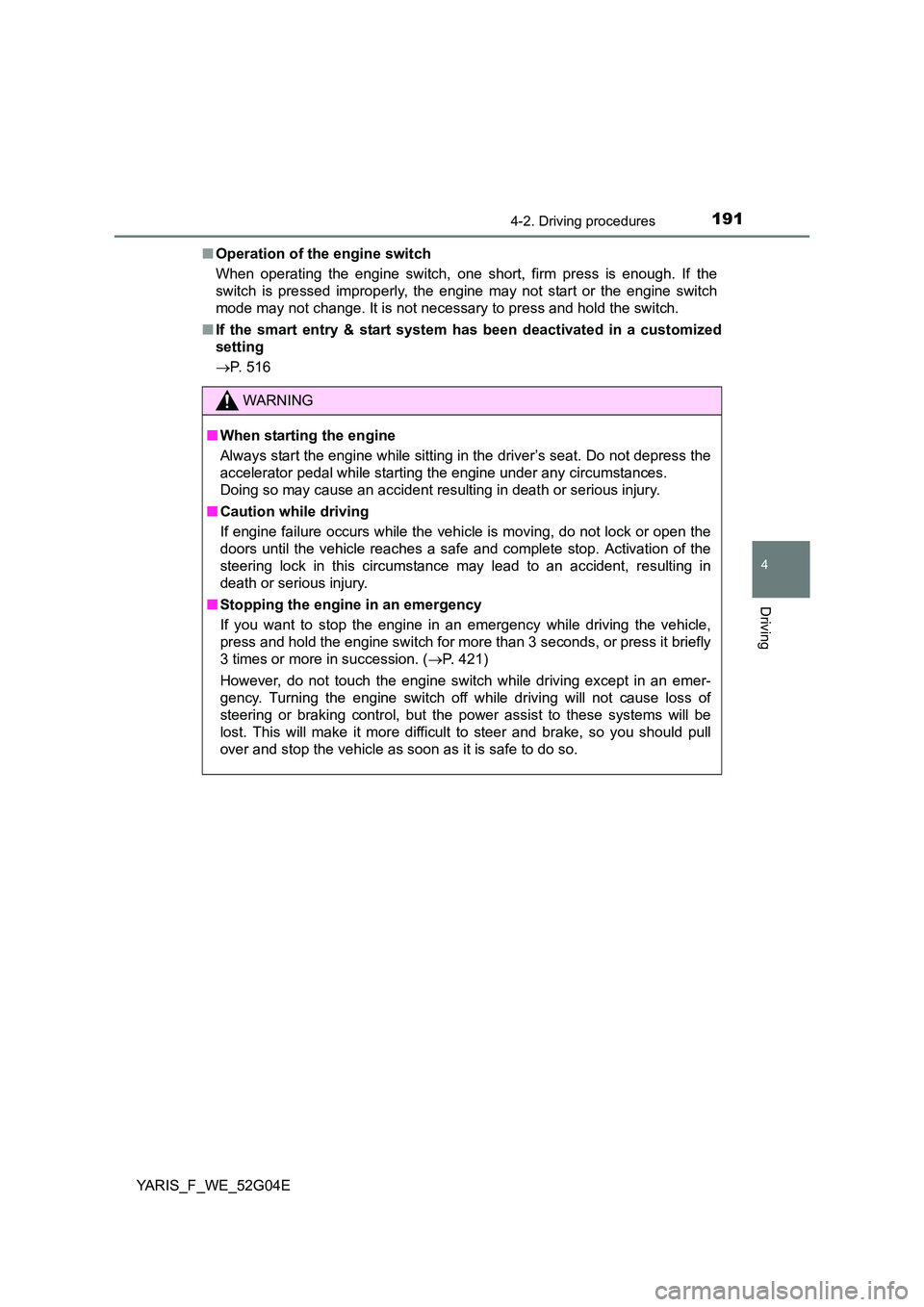
1914-2. Driving procedures
4
Driving
YARIS_F_WE_52G04E
■ Operation of the engine switch
When operating the engine switch, one short, firm press is enough. If the
switch is pressed improperly, the engi ne may not start or the engine switch
mode may not change. It is not necessary to press and hold the switch.
■ If the smart entry & start system has been deactivated in a customized
setting
P. 516
WARNING
■When starting the engine
Always start the engine while sitting in the driver’s seat. Do not depress the
accelerator pedal while starting the engine under any circumstances.
Doing so may cause an accident resulting in death or serious injury.
■ Caution while driving
If engine failure occurs while the vehicle is moving, do not lock or open the
doors until the vehicle reaches a safe and complete stop. Activation of the
steering lock in this circumstance may lead to an accident, resulting in
death or serious injury.
■ Stopping the engine in an emergency
If you want to stop the engine in an emergency while driving the vehicle,
press and hold the engine switch for more than 3 seconds, or press it briefly
3 times or more in succession. ( P. 421)
However, do not touch the engine switch while driving except in an emer-
gency. Turning the engine switch off while driving will not cause loss of
steering or braking control, but the power assist to these systems will be
lost. This will make it more difficult to steer and brake, so you should pull
over and stop the vehicle as soon as it is safe to do so.
Page 260 of 540
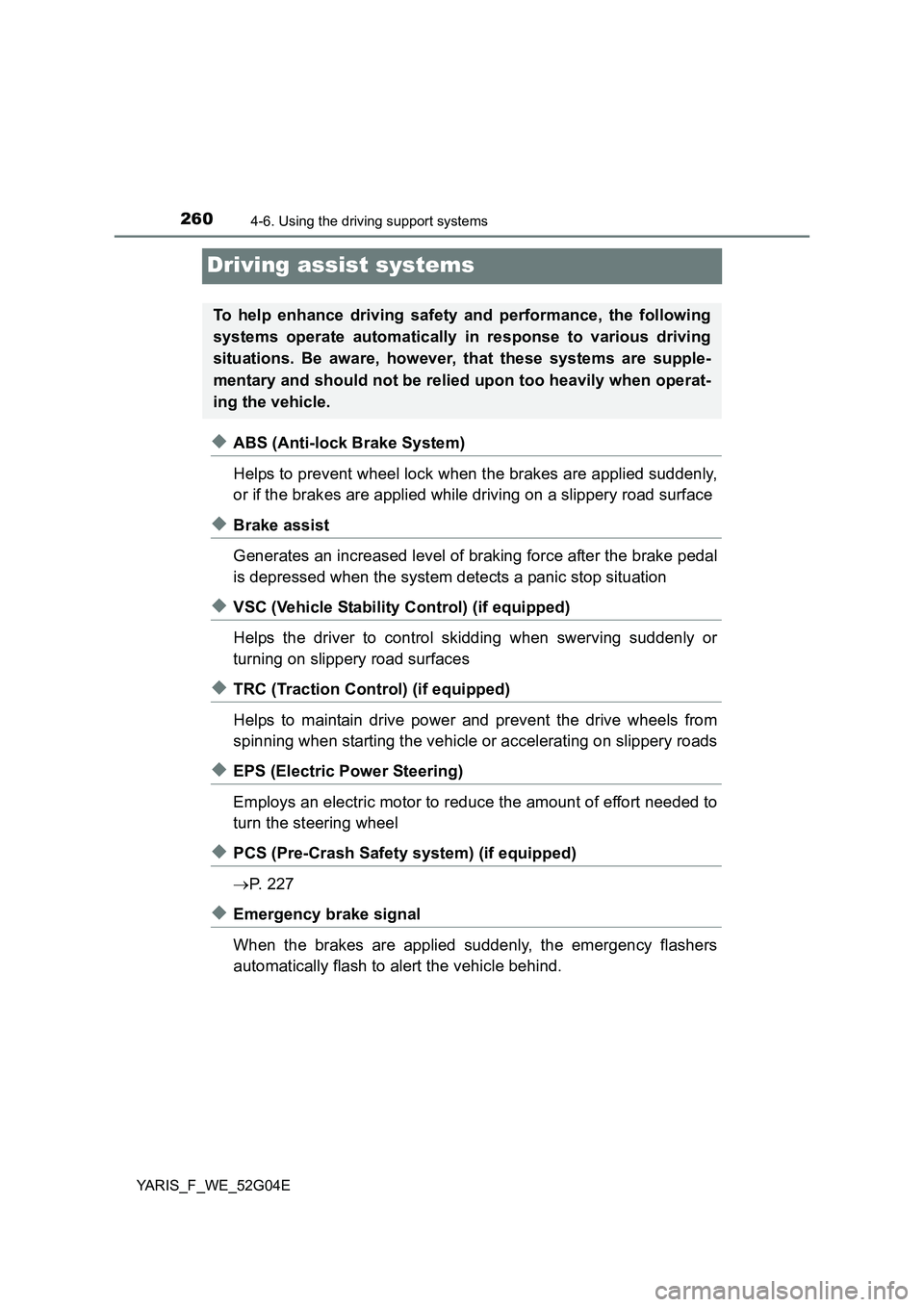
2604-6. Using the driving support systems
YARIS_F_WE_52G04E
Driving assist systems
◆ABS (Anti-lock Brake System)
Helps to prevent wheel lock when the brakes are applied suddenly,
or if the brakes are applied while driving on a slippery road surface
◆Brake assist
Generates an increased level of braking force after the brake pedal
is depressed when the system detects a panic stop situation
◆VSC (Vehicle Stability Control) (if equipped)
Helps the driver to control skidding when swerving suddenly or
turning on slippery road surfaces
◆TRC (Traction Control) (if equipped)
Helps to maintain drive power and prevent the drive wheels from
spinning when starting the vehicle or accelerating on slippery roads
◆EPS (Electric Power Steering)
Employs an electric motor to reduce the amount of effort needed to
turn the steering wheel
◆PCS (Pre-Crash Safety system) (if equipped)
P. 2 2 7
◆Emergency brake signal
When the brakes are applied suddenly, the emergency flashers
automatically flash to alert the vehicle behind.
To help enhance driving safety and performance, the following
systems operate automatically in response to various driving
situations. Be aware, however, that these systems are supple-
mentary and should not be relied upon too heavily when operat-
ing the vehicle.